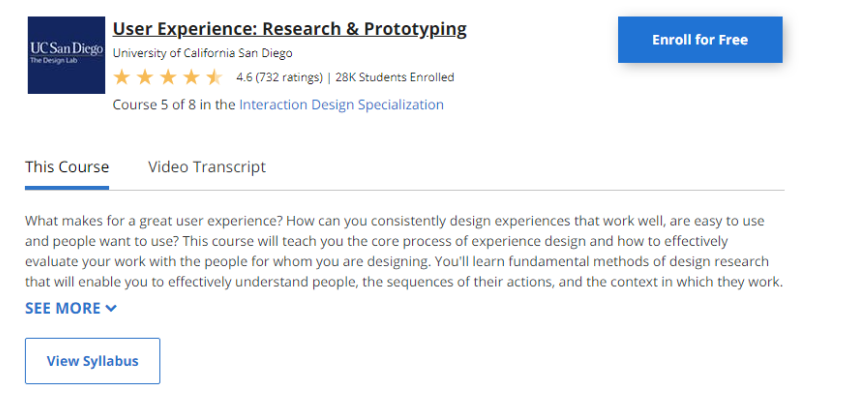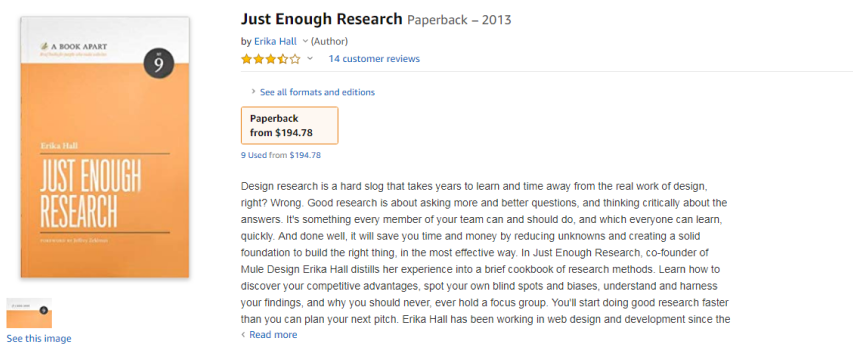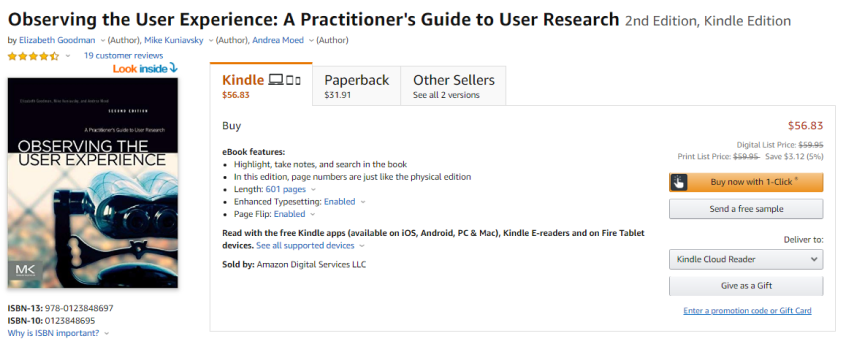
User research is part and parcel of a successful design. Understand people who will use your design, apply this knowledge while creating personas and customer journey maps, put them into use, and you will nail it.
Like any other discipline, user research requires specific knowledge and skills. There is a flood of learning materials on UX, both online and offline, but the sources are surprisingly scarce when it comes to user research.
I'm telling you this from my personal experience. When I was transitioning from cultural anthropology into UX, I spent much time figuring out how to apply my knowledge to a new setting.
At that time, I set out to create a list of useful learning assets for newcomers to user research.
Talking to UXPressia users from different countries, I found out that they were looking for something like my list. That’s why I decided to write a post to share with you the useful learning resources on user research for beginners I collected.
I will introduce you to the courses, training, and books created by practitioners for practitioners and even more. Read on the post to find learning sources that will work best for you.
Contents
Best online user research courses for novices
Some of the courses found in this section are free, some are paid. They vary in duration, content, and delivery. Dive in and see which one better suits your needs.
User Experience (UX): The Ultimate Guide to Usability and UX

I deliberately placed this course first. It provides a great introduction to user experience, and its scope is much wider than just user research. The course is a great starting point even for those who have some UX knowledge. It will help you put user research in context, making it truly worth your time.
The course contains numerous excellent examples. In a nutshell, it tells a story that develops gradually from lesson to lesson and so does the learner’s understanding of the subject matter.
The course consists of short, easily digestible videos overviewing the most common research methods. It also guides you to additional resources to deepen your knowledge.
Pros
- In-depth course
- Explains the business value of UX
- Lots of examples
- Practical exercises
- Certificate of completion
Cons
- Broad in scope: not all topics cover user research
- Paid
User Research – Methods and Best Practices

User Research – Methods and Best Practices is a part of the six-course series User Researcher Learning Path by Interaction Design Foundation. Whether you’re trying to break into user research and change your career or find useful research techniques to help you in your current role, this course got you covered.
Combining video lectures with text-based learning materials, the course gives a detailed overview of qualitative research methods.
Don’t be surprised that quantitative research methods are not covered. Qualitative UX research is usually what a professional researcher does at the beginning of a new project. Applying these methods puts you in direct contact with the user. It also allows you to immerse yourself into the context to see the goals, motivations, and tasks from the user’s perspective.
Pay special attention to the lecture on the ROI of user research. It may help you convince your boss to invest in UX research.
Tip: if you have zero experience with UX, check out User Experience: The Beginner’s Guide and Design Thinking: The Beginner’s Guide in the same course series.
Pros:
- In-depth course
- A great mix of educational materials
- Tests with open-ended questions evaluated by the instructor
- Practical exercises
- Discussion forums
- Certificate of completion
Cons:
- Requires a basic understanding of UX
- Time-consuming
- Paid
User Experience: Research & Prototyping

User Experience: Research & Prototyping is part of the Interaction Design Specialization, which covers a broad range of UX topics. Week one of the course is dedicated to qualitative methods, which are particularly useful for user research.
The content is video-based and easy to access at any time. One of the perks of this course is that participants are required to conduct research as a practical exercise. The results of each study are peer-reviewed by other people taking the course. So, you get immediate feedback on your work, and this helps you learn quickly.
Pros:
- Practical peer-reviewed assignment
- Evaluated quiz
- Discussion forums
- Free in the audit mode
- Certificate of completion (only in the full version)
Cons:
- Partially devoted to research
- The full version is paid
Beyond Usability: Learn the User Research Toolkit

Beyond Usability: Learn the User Research Toolkit presents a high-level overview of both qualitative and quantitative user research methods. It will take you less than an hour to watch the course lectures.
There’s a very brief introduction to user research techniques. But the suggestions for applying different methods to specific problem areas provided at the end of the course are certainly valuable.
Another perk is that the course is divided into bite-sized videos. The course is free.
Pros:
- Introduction to qualitative and a glimpse of quantitative methods
- Only takes 1 hour
- Free
Cons:
- High-level overview
- Theory-based
- No practical exercises
Books on User Research for Beginners
Reading books on user research may take more time than watching video lectures. However, systematic learning is a long-term investment in your project and your career in UX. Here are the best user research books for beginners that I read.
The User Experience Team of One: A Research and Design Survival Guide

The book by Leah Buley is not limited to user research; it’s much broader than that. If you’re the only person in your company who cares about UX, it's a must-read.
Leah Buley provided an accurate summary of each chapter. If you don’t have time to read the whole thing, examine the summaries to choose the chapters to read in full.
As for user research beginners, I find two book chapters particularly relevant:
- Chapter 3, “Building Support for Your Work” gives you some tips and tricks for overcoming common objections to conducting user research.
- Chapter 6, “Research Methods,” does not aim to give you a profound understanding of user research methods but to provide you with efficient techniques that will work for almost any project. The author provides an estimated timeline for each method and gives tips on when to use it.
Pros:
- A comprehensive introduction to UX
- Helpful summaries
- Tips on getting support for UX initiatives and building a career
- Reads easily
Cons:
- Quite long
- Only research basics are covered
Just Enough Research

In the book, Just Enough Research, Erika Hall explains what design research is and what it is not. She demonstrates how to introduce different types of research to your organization when resources are scarce and how to promote the research agenda.
This book is very practical and explains complex concepts in a simple language understood by user research beginners. It's quite short and meant to be read in full. While reading, I recommend that you pay special attention to three chapters:
- In Chapter 3, “The Process”, you will read how to establish a systematic approach to research, no matter the scale of your research initiative. The algorithm described there will help you with all future research endeavors.
- In Chapter 4, “Organizational research”, the author focuses on the importance of understanding the culture and inner dynamics of the organization you work for or collaborate with as an external consultant for UX activities.
- In Chapter 5, “User Research”, Erica Hall tells the reader to go beyond usability testing. She advises the reader to leverage elements of ethnography to develop empathy with users. What for? With this method, you will deeply learn the behavior of the people you’re designing for and understand why they act the way they do. If you’re completely new to user research, understanding the users’ context is the place to start.
Pros:
- Introduction to qualitative and quantitative methods
- Tips on promoting research in your company
- Reads easily
- Short
Cons:
- No summaries
- Chapters make better sense when reading in the original order
Observing the User Experience: A Practitioner's Guide to User Research

Observing the User Experience is a user research classic that is not meant to be read in one sitting. Mike Kuniavsky, Elizabeth Goodman, and Andrea Moed encourage readers to explore the chapters as needed.
The book details a wide range of user research techniques, both qualitative and quantitative. The authors provide examples from their own work experience of applying each technique.
This book is written for more advanced users than the first two. It’s on my list because it explains how to analyze research results and present findings to the team during the discussion of research techniques.
At the end of the day, the success of your research is not only about doing it right and asking the right questions. It’s also about being able to communicate findings and convince stakeholders.
Pros:
- In-depth introduction to qualitative and quantitative methods
- Real-life examples from the industry
- Chapters can be read individually in any order
Cons:
- Intended for a more advanced audience
- Long read
Finally, I would like to share some other sources where you’ll find user research materials.
Additional sources on user research for beginners

Reading blogs may be the easiest way to learn a thing or two about user research without investing too much time. They are also a place to read about the latest trends in the field.
Norman Nielsen Group
Norman Nielsen Group is an industry leader and one of the most authoritative sources on user research and all things UX. Read this article first — it explains how to choose the right research method.
UX Collective
The User Research and User Testing section of the UX Collective’s blog contains various articles on the subject matter written by practitioners worldwide.
Usabilityworks
Usabilityworks is a website created by a renowned user researcher Dana Chisnell. In the blog, she writes about research and data analysis techniques. There is also a small library of public talks the author held over the years.
Ethnography Matters
If you want to learn more about ethnography and its application in a broader context, try Ethnography Matters.
Last but not least, there is an article on secondary research methods, which is useful for cases when direct interaction with users is unavailable. Though the techniques mentioned there are complementary and should normally accompany actual user research, if you’re having trouble advocating for research in your company, this is a place to start.
Take a step into the unknown
I’m a firm believer that user research doesn’t have to be intimidating. Even ad hoc, beginner-level research activities prove to be effective compared to not doing any research at all. Try out learning materials for user research for beginners from the list, take a leap of faith and throw yourself into the unknown world of user research. I promise it will be fun.



